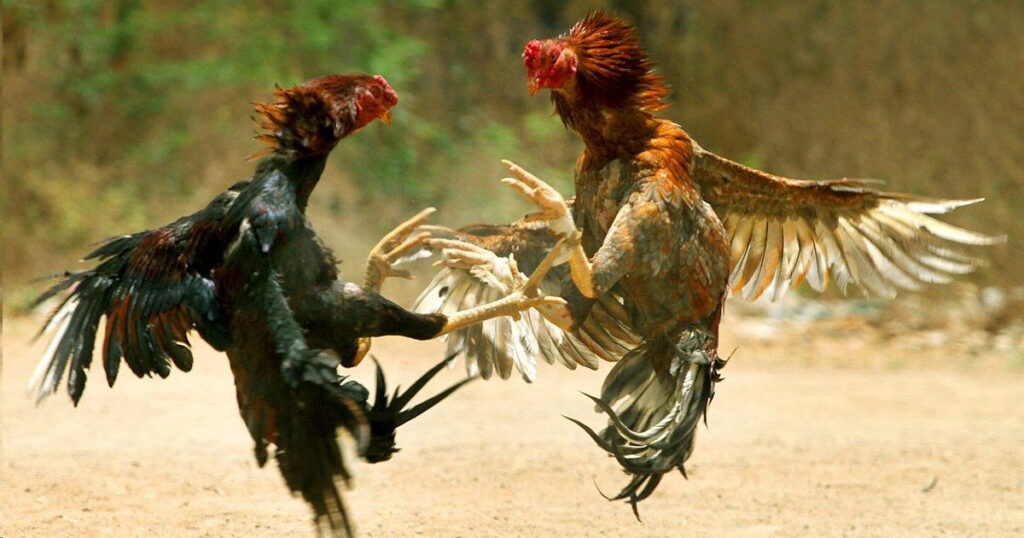
Rooster fighting is a centuries-old blood sport in Pakistan.
Two male roosters, being naturally aggressive towards males of the same species, are set against each other to engage in combat. Possibly the earliest observed spectator game in human history, it is illegal and prohibited but still rampant in Pakistan.
Rooster fighting and wagering on the roosters is legally banned under the Public Gambling Act 1867, the Prevention of Cruelty to Animals Act 1890, and the Pakistan Penal Code 1860, but you can still expect to see it in festivals in most rural areas of the country, where it is considered a popular sport.
Khufti roosters can cost from Rs 10,000 to Rs1 million and the price depends on the lineage of the rooster and its achievements in the clashes. Some old, weak, and injured roosters that may have lost an eye during fights are retained for breeding, while some are sold off.
Identifying a top fighting rooster and being able to distinguish between different kinds of roosters’ breeds is viewed as an extraordinary proficiency, one that not everyone has.
The most commonly used breed for rooster fighting in Pakistan is known as ‘aseel.’ “It is preferred over other breeds because of its stamina and combative nature. “Other types include Sindhi aseel, Jagiri aseel, Mianwali aseel, lasani aseel, nawab wale kalay aseel, and Amroha aseel. Aseel roosters come in various colours, each with distinctive features.”
A rooster with five white wings and a different-coloured body is known as ‘lal par,’ while a white rooster is referred to as ‘hero.’ Another variation is the ‘phulyu,’ which has white spots on a black or brown body.
A fighting rooster’s performance can vary significantly with weight and height, hence the ‘muhro’ or standard weight of a fighting rooster is meticulously observed by breeders and trainers to find the ideal balance of agility, strength, and endurance. Through careful monitoring and adjustment of their care regimen, breeders strive to maintain their fighting roosters in prime condition for optimal performance in competitions.
A top-notch fighting rooster typically has large nostrils covered by a raised tan patch. This feature is crucial as it facilitates proper breathing, especially during winter when respiratory discomfort can affect stamina during fights. A robust neck characterized by ample fat and width is essential. Roosters with low feather density on the neck must have thick skin to withstand the grip of their opponents. Conversely, those with a high density of neck feathers may not necessarily require thick skin. Strong and large wings are also imperative for superlative performance.
A rooster begins its journey into the world of fighting at around 18 months of age. Surviving the intense fights, it can continue for another 2.5 years.
After its initial victory, one rooster can fight twice in the same festival. Some roosters defeat their opponents in only 2 to 3 minutes, while others may take 2 to 6 rounds. Each fighting round lasts for 5 minutes, followed by a mandatory break. Sadly, death in the ring is not uncommon. Despite their fierce fighting spirit, many roosters are killed in the brutal sport. Occasionally, after a prolonged fight, the roosters may become too fatigued to continue, resulting in a withdrawal of the match with no clear winner.
The community of rooster-fighters gathers daily in groups of 3 to 25 people in autaqs [exclusive quarters for men in homes], shops, and tea-cafes in Shahdadkot city to exchange stories about fighting roosters. Abdul Hameed, a khufti, has been raising roosters for this blood sport for the past 40 years but hardly feels any remorse for putting these birds through cruelty.
Some khuftis, such as Allah Dino, love their birds yet are ready to use them for a blood sport. despite the popular demand. “I have never sold my roosters to anyone despite many offers. I told my feudal lord and murshid [spiritual guide] that I can part with my children and wife, but not my fighting roosters.
The conversations among rooster fighters are packed with stories of cruelty to animals and exploitation of people. There is apathy towards violence that usually accompanies a lack of awareness. They appear to have no remorse for inflicting torturous cruelty on these birds and seem to revel in it.
“I don’t feel sorry for the roosters as they fight because of their genetic programming,” says Hameed. “I do not force them. If they choose not to combat, then obviously, I cannot make them fight. My father was keenly interested in this game. Initially, I looked after his birds as a child and later got into the sport myself. Presently, my sons actively participate too, so this is our third generation indulging in this sport.
Prior to the clash, sharp spurs are affixed to each leg of the rooster. This practice reflects brutal and vicious cruelty.
People engage in rooster duels habitually as a misguided notion of masculinity and power, aiming to establish their supremacy over frail creatures for their own distorted perception of amusement. They attain perverse satisfaction from observing innocent birds rip each other apart ferociously, delighting in the bloodshed and brutality akin to the savagery of ancient barbarians. They reflect a dearth of understanding and care, and they see the agony of birds as nothing more than an amusement instead of realizing the intrinsic harshness and unfairness of their actions.
Their involvement in fowl fighting echoes a profound, moral bankruptcy and utter disregard for the well-being of sentient creatures, displaying deep-seated absence of humanity and integrity. It is a reprehensible and dastardly practice that is entitled to rebuke and disdain from the civil society.
Dr Abu Bakar, a psychiatrist, says that the adrenaline surge linked with these competitions can be attractive to some people
The anticipation of an uncertain outcome can captivate and create an enthusiastic engagement among the spectators. Frequent exposure to the bloodshed and violence in these competitions can desensitize people, and they become more accommodating so that their appetite for aggression and cruelty against birds grows and may extend to other aspects of life and potentially towards family and friends.
The rooster-fighting competitions are of three types. The first type, hosted within the premises owned by the feudal lords, draws 150 to 300 spectators. The second type of festivals are held outside the city, where a crowd of 1000 to 1200 assembles. The third and the grandest draw seven or eight thousand participants for clashes of more than 150 pairs of roosters. The organizers receive ten percent from the bets on each pair. These festivities are organized throughout the year except during the sacred months of Ramadan and the first 10 days of Muharram.
In the face of dire poverty, aggravated by disastrous floods in Sindh, the blood sport has become even more rampant. Instead of prioritizing their families’ well-being, people shamelessly funnel significant sums into feeding gamecocks for this cruel sport.
“I feed my roosters butter, almonds, pistachios, eggs, milk, and a rich protein diet to make them strong and aggressive,’ says Abdul Nabi, a 45-year-old carpenter, talking about how the birds are prepared for fights. Despite his family members living in harsh conditions and his children suffering from malnutrition, he prioritizes the well-being of his roosters for fighting purposes, feeding them an expensive diet.
The element of gambling in these duels adds further depravity to the situation. “I have never trained or owned a bird for fighting in my entire life, but I possess two decades of experience in this field,’ says Noorullah Brohi, a 58-year-old businessman who attends these festivals primarily to bet on the duels. “I have honed my skills in betting on the roosters, taking the time to observe and understand each rooster and his owner. It gives me a distinct edge for consistent victories.”
Before the fight even begins, a predetermined gambling amount is set, and the winner claims the amount ranging from 10,000 to 2 million rupees or even more in some fights. Ten percent goes to each handler and organizers. Viewers who place bets among themselves keep their entire wager, with no portion going to the winner.”
In their insanity of trying to rear the most competitive rooster, they even resort to the administration of various steroids and injections to the roosters in the days leading up to combat. This unethical, unprofessional, and inhuman approach is meant to artificially raise the birds’ power and aggression, ultimately intensifying the brutality of the confrontations and compromising the roosters’ health.
Before competition, a mixture of neurobion, methycobal, and vitamin D3 injections are given to the roosters to bolster their strength. We also use other imported steroids. Finally, after winning, the rooster’s wounds are washed with salt water to dry the blood, and preparation begins for the next fight.
For some people, rooster fighting is a way to socialize. “While I’m not particularly drawn to the fighting aspect, I go to these duels for social purposes,’ says Rais Zohaib Ali, a landlord. “Generally, other landlords and influentials of the area are present at these competitions and festivals, through which I have made a lot of friends. I send them fighting roosters as gifts, and now the khuftis endorse me as a benevolent individual.”
The khuftis believe that the presence of menstruating women near game fowl is considered a bad omen. On the flip side, for a good omen before a clash, smoke is applied to the bird’s feet, while others seek blessings at the shrines of saints for victory in clashes. Some also resort to black magic, using amulets against their opponent’s rooster.
Rooster fighting is strictly forbidden according to Hadith as well in Islam,” says Hafiz M Ayub, Imam of a mosque, as he narrated from Ibn Abbas (RA): “The Messenger of Allah (PBUH) prohibited inciting beasts for fighting. Sunah Imam Abu Daud (2562). Finding entertainment and solace in bird fighting is a reflection of a warped psychological build-up of people who prioritize temporary enjoyment over compassion and empathy.
Promptly opposed by all the stakeholders of society, this blood sport should unequivocally be denounced and made a punishable offense.
